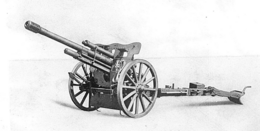7,5 cm FK 38
Da Wikipedia, l'enciclopedia libera.
| 7,5 cm Feldkanone 38 7,5 FK 38 | |
|---|---|
 | |
| Tipo | cannone da campagna |
| Origine | |
| Impiego | |
| Utilizzatori | |
| Conflitti | Seconda guerra mondiale |
| Produzione | |
| Progettista | Krupp |
| Costruttore | Krupp |
| Entrata in servizio | 1939 |
| Ritiro dal servizio | 1945 |
| Numero prodotto | 144 |
| Descrizione | |
| Peso | 1 366 kg |
| Lunghezza canna | 2,55 m |
| Calibro | 75 mm |
| Tipo munizioni | cartoccio proietto |
| Peso proiettile | HE: 5,85 kg AP: 6,3 kg |
| Cadenza di tiro | 8-10 rpm |
| Velocità alla volata | 605 m/s |
| Gittata massima | 11 500 m |
| Elevazione | -5°/+45° |
| Angolo di tiro | 50° |
| Sviluppata da | 7,5 cm FK 18 |
| voci di armi d'artiglieria presenti su Wikipedia | |
Il 7,5 cm Feldkanone 38, abbreviato in 7,5 cm FK 38[1], era un cannone da campagna tedesco, prodotto dalla Krupp per soddisfare un ordine dell'esercito brasiliano, ma solo 64 pezzi furono consegnati prima dello scoppio della seconda guerra mondiale. Nel 1942, per far fronte alle richieste della Wehrmacht, Krupp completò i cannoni rimanenti e ne consegnò 80 allo Heer.
Tecnica
[modifica | modifica wikitesto]Il FK 38 aveva una canna derivata dal 7,5 cm FK 18, allungata a 34 calibri e dotata di freno di bocca cilindrico; questo, originariamente a 6 luci, fu poi sostituito di disegno standard tedesco a 4 luci. Le prime versioni avevano ruote con raggi in legno, sostituiti sui pezzi di produzione bellica da ruote in acciaio stampato con semipneumatici in gomma. Il cannone montava una versione semi-automatica dell'otturatore originale del FK 18 ed impiegava munizioni fisse a cartoccio proietto invece che quelle separate del predecessore. Queste modifiche consentivano una cadenza di tiro notevolmente superiore al FK 18.
-
7,5 cm Feldkanone 38
-
7,5 cm Feldkanone 38
-
7,5 cm Feldkanone 38
Note
[modifica | modifica wikitesto]- ^ Nella nomenclatura tedesca dell'epoca: cannone campale calibro 7,5 cm modello 1938.
Bibliografia
[modifica | modifica wikitesto]- Gander, Terry and Chamberlain, Peter. Weapons of the Third Reich: An Encyclopedic Survey of All Small Arms, Artillery and Special Weapons of the German Land Forces 1939-1945, Doubleday, New York, 1979. ISBN 0-385-15090-3.
- Hogg, Ian V. German Artillery of World War Two, Stackpole Books, Mechanicsville, 1997. ISBN 1-85367-480-X.
- Engelmann, Joachim e Scheibert, Horst. Deutsche Artillerie 1934-1945: Eine Dokumentation in Text, Skizzen und Bildern: Ausrüstung, Gliederung, Ausbildung, Führung, Einsatz, C. A. Starke, Limburg/Lahn, 1974.
Text is available under the CC BY-SA 4.0 license; additional terms may apply.
Images, videos and audio are available under their respective licenses.


